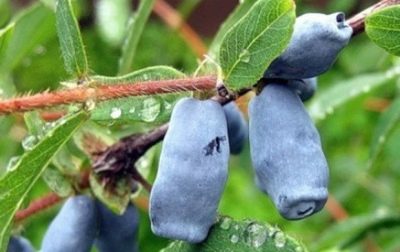
- Authors: Plekhanova Maria Nikolaevna, Kondrikova Alexandra Vasilievna (VIR named after N.I. Vavilov)
- Year of approval: 2002
- Growth type: vigorous
- Description of the bush: wide
- Escapes: straight, upward, light pink, well leafy, slightly pubescent
- Leaves: large, oval, dark green, slightly pubescent
- Crown: reverse conical, thick
- Fruit size: average
- Fruit weight, g: 0,8
- Fruit shape: wide-spindly
Slavyanka is a honeysuckle variety bred by Russian breeders and approved for use in 2002. It is a versatile variety that has a very rich berry flavor. Let's get to know Slavyanka in more detail.
Description of the variety
The bush is distinguished by great vigor of growth, wide, has a dense crown in the form of an inverse cone. Shoots are straight, grow upward, slightly hairy and well leafy, oval leaves, large, dark green, slightly pubescent.
Fruit characteristics
The berries are medium in size, weighing about 0.8 g, have a thin bluish-blue skin with a slight waxy bloom. If the crop is a little immature, then you can store it in the refrigerator or cellar for 7-12 days. If the berries are fully ripe, then their shelf life is limited to 2-3 days.
Taste qualities
The berries are characterized by a delicate sweet and sour pulp with a pronounced aroma. The composition contains vitamin C, and the taste is estimated at 4.5 points.
Ripening and fruiting
Slavyanka belongs to varieties with a mid-season ripening period. Harvesting is usually done in late May or early June, while the berries do not ripen at the same time, so it is customary to divide the harvest into several stages. Keep in mind that overripe berries can crumble, so do not delay picking.
Yield
This is a high-yielding variety, yielding an average of 40 c / ha, and the maximum yield of Slavyanka is 2.1 kg per bush or 70 c / ha.

Self-fertility and the need for pollinators
To ensure active fruiting and a rich harvest, you need to plant pollinating varieties next to the bush. Cinderella, Blue Bird, Tomichka proved their effectiveness in this matter.
Growing and care
Before planting a bush, you need to pay special attention to the choice of the site. The presented variety will grow well in moisture-absorbing loamy or sandy loam soil, while the ridge should be located in the sun or in partial shade. To improve the structure of the soil, you should enrich it with matured compost. If you plant a bush in a too shaded place, then its berries will be less tasty with a bitter taste. Disembarkation is allowed both in spring and autumn. After planting, the branches of the seedling need to be cut slightly and the soil should be mulched.
Caring for the presented variety is reduced to systematic feeding, weeding and watering as needed. In the early years, the plant needs rare pruning, but starting from 5-6 years of age, the tree needs to be rejuvenated more often. If old, thickened and diseased branches are removed in a timely manner, then the culture will delight with the harvest every year for 38-40 years.


Disease and pest resistance
Slavyanka is characterized by a very high immunity to diseases and insects. In extremely rare cases, it can be affected by powdery mildew and aphids. To avoid this, treat the bush with special agents with a fungicide 2-3 times per season at intervals of 10 days, but keep in mind that processing should be stopped at least two weeks before harvest.

Winter hardiness and the need for shelter
Slavyanka can be grown without problems in regions with a harsh climate, since it is highly frost-resistant. The bush is able to withstand temperatures up to -45 degrees without shelter. Even blooming flowers that do not freeze out at temperatures down to -7 degrees are considered winter-hardy.

Review overview
Slavyanka receives high marks from both farmers and consumers. Its berries are used for the prevention of cardiovascular diseases; delicious jams and compotes can be prepared from the fruits. According to the observations of gardeners, fruiting mainly begins in the second year after planting, while aesthetic bushes can be used not only to obtain a rich harvest, but also to decorate the personal plot.































































